

Pittsburgh
1948 Panthers
(Authentic Reproduction)
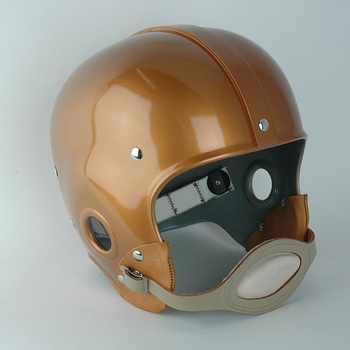
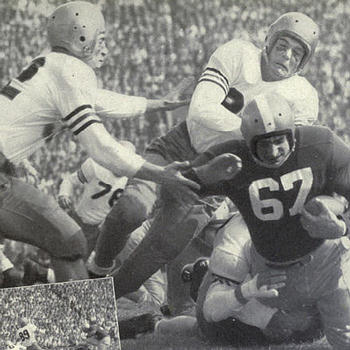
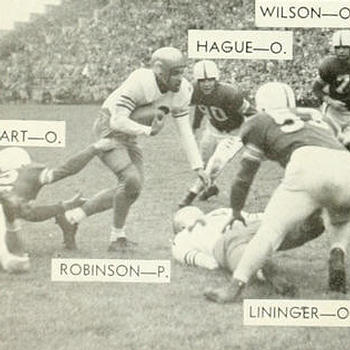
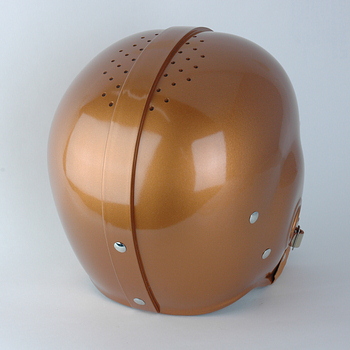
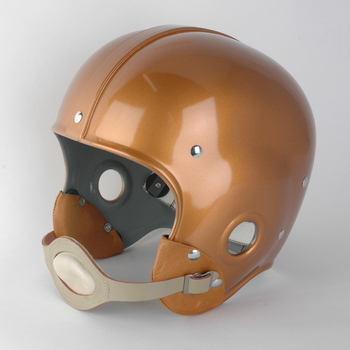
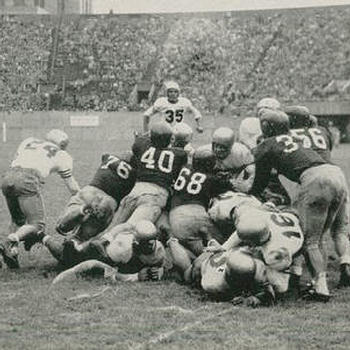
For the 1947 season, another former Sutherland player, Walter “Mike” Milligan who had been Fesler’s chief assistant coach, was promoted to the head job. Milligan had been one of Pitt’s local “tough guy” performers out of Aliquippa, a 168 pound guard on two of Sutherland’s National Championship teams. He served as Sutherland’s freshman team coach and then as a highly respected line coach from 1934 until resigning with the entire Sutherland staff after the ’38 season. He built his coaching resume at Florida and Tulsa, where he also served as the head basketball coach for a season, until returning as Wes Fesler’s top assistant for the 1946 season. When Fesler left for Ohio State, Milligan was promoted to the head coaching spot. Reintroducing Sutherland’s Single Wing to a team that had been built upon the T-Formation since 1943 resulted in a one-win season with that one victory coincidentally coming over former Pitt coach Wes Fesler’s Ohio State Buckeyes. Ends Leo Skladany and Bill McPeak joined with HB and kick return man extraordinaire Jimmy Joe Robinson to anchor the team. Milligan also introduced a helmet style that would remain in use for ten seasons, an Old Gold shell with a one-inch navy blue center stripe. This restored the use of Pitt’s colors, with the Navy blue stripe being removed only for the 1948 season. Against the usual horrifically difficult schedule, Milligan brought the 1948 squad to a 6-3 mark which included a shutout victory over Penn State that snapped the Nittany Lions seventeen game winning streak. Again, McPeak who later would become the head coach of the Washington Redskins and Skladany, were the stalwarts on the line of scrimmage. Skladany played for the Eagles and completed his rookie season by helping to win the NFL Championship game by blocking a kick. He spent another year with the Giants and later became a popular tavern owner. Robinson set a school record with a 100-yard kickoff return against Purdue. Tackle Nick Bolkovac and guard Mike Boldin were team tough guys while HB Lou “Bimbo” Cecconi, who with future Los Angeles great “Deacon” Dan Towler had led Donora, PA High School to glory, and FB Carl DePasqua were major contributors to the turnaround. Though the 1949 season resulted in another 6-3 record, it was highlighted by a 16-7 upset of Rose Bowl champ Northwestern, another shutout over Penn State, and a huge 22-21 victory over Penn. Many of ‘48’s top men keyed what appeared to be Pitt’s stabilization of the program with All American guard Bernie Borousie leading Cecconi, Robinson, and DePasqua who made for a formidable group of backs. DePasqua would return to Pitt in 1969 as the Panthers’ head coach, and Robinson became a respected minister in the Pittsburgh area. At the end of the season, Milligan requested a two-year contract. Athletic Director Tom Hamilton, the former commander of the USS Enterprise aircraft carrier during WW II combat, refused to offer more than what was then the Pitt standard of a one-year deal and Milligan opted to leave. He remained a respected assistant coach specializing in line play and was an assistant at USC, Purdue, and Nebraska.
With Milligan gone as coach, AD Hamilton offered Santa Clara’s head man Len Casanova a four-year contract. Some speculated that Casanova, a former Santa Clara halfback had the bearing and demeanor that Hamilton was seeking in a head coach. The football mentor with the “Latin-lover” last name was actually a straight-laced former Naval Commander with an impeccable background and a military manner. Unfortunately, the team was decimated by the military draft and enlistments because of the Korean conflict and he was immediately faced with a juggling act to put a competitive team onto the field. This was made more complicated by switching back to the Single-Wing Formation which had brought Casanova success at Santa Clara. He converted defensive back Bob Bestwick to quarterback and teamed him with end Chris Warringer. Bestwick responded with 1165 passing yards, becoming the first Pitt player to top the 1000 yard mark. Fullback Joe Capp was the Panthers' leading rusher and received run support from HB Lou Cimarelli and back-up fullback/linebacker Joe Schmidt. Joe Zombek played well at defensive end but without enough quality players left, the team defeated only rival West Virginia and limped through the year at 1-8 with kicker Nick Bolkovac who later played with the Steelers as their most serious scoring threat. During the summer of ‘51, head coach Casanova came to Hamilton and asked to be released from his contract. Citing the declining health of his daughter who had not responded well to the cold Pittsburgh weather, he jumped at the opportunity to return to the West Coast and took the head job at Oregon where he remained from '51 through the 1966 season. Athletic Director Hamilton was forced to take on the additional role of head coach and again the squad faced a weekly task of placing a depleted lineup onto the field due to manpower shortages. He switched fullback Schmidt to guard and played him at linebacker on every defensive play. The pass-catch combination of QB Bestwick and end Chris Warringer was again the major Panthers’ offensive weapon and HB Cimarelli stepped up and became the team's top scorer. 1950's rush leader Joe Capps went out for the year with injury, leaving the load to Cimarelli and Bob Epps. Joe Zombek, a future Steeler, teamed with Schmidt to play decent defense and despite the late coaching change, the record improved to 3-7.
Athletic Director Hamilton had time to find a coach immediately after the 1951 season and returned to administrative work after hiring Lowell "Red" Dawson. Dawson had quarterbacked Tulane to the Rose Bowl in 1932 and had served as a Minnesota assistant, the head coach at his alma mater, and the head man for the Buffalo Bills of the All American Football Conference. When the professional league went under, he became the coach of the highly charged Michigan State backfield and then jumped at the Pitt job. He inherited Joe Schmidt who played guard but truly was at home at the linebacker position that would win him both a College and Pro Football Hall Of Fame election after a fabulous NFL career with the Lions. Even with multiple injuries, Schmidt was in a class by himself. Pete Neft and Henry Ford shared the QB position but the emerging stars were HB Richie McCabe and fullbacks Bobby Grier and Bobby Epps. A surprising choice for the Look Magazine All American team was sophomore tackle Eldred Kraemer who had never played high school football! Dawson was shut out by both West Virginia and Penn State but moved the overall record to a very much improved 6-3 and included a tremendous 22-19 upset of Notre Dame among those victories.
SPOTLIGHT ON JOE SCHMIDT:
When one thinks of a College and Pro Football Hall Of Fame linebacker, the vision usually includes an outstanding junior high school and high school career, a recruiting race to land the sought-after star, and a sterling collegiate performance before embarking on a professional career. In Joe Schmidt's case, he truly got a late start as he attended a junior high school so small, it had no football team. Instead, he followed his older brother John onto the sandlots of Pittsburgh to play football, a boy among men. John Schmidt had played for the 1938 Carnegie Tech team that went to the Sugar Bowl and he kept a hand in the game by coaching a local sandlot team composed primarily of World War II veterans. Young brother Joe had no other football outlet other than the head-banging, bloody weekend games played with and against older teens and grown men, for whatever a passing of the hat brought in. At Pittsburgh's Brentwood High School, young Joe never even thought to take the field until his junior year but when he did, he was a powerful force at fullback and a lot tougher than the other high school players. He went to Pitt as a fullback and linebacker and was switched to offensive guard his sophomore year. There was no need to switch him from linebacker as Schmidt was a natural, hunting down and decimating ball carriers. At 6'1" and 210 pounds, his sixty-minute per game performances earned him the honor of being team captain and All American, and also earned him numerous injuries; two broken ribs as a freshman, a broken wrist during the spring prior to his sophomore season, a separated shoulder during his second season, a severely sprained knee as a junior, and torn knee cartilage in the opening game his senior season. He followed that up by returning two games later and incurring a severe concussion and hemorrhage against Notre Dame, contact that hospitalized him for ten days. Upon meeting with some of the Steelers’ personnel at the team's offices one afternoon, Mr. Rooney walked into the room and said upon his introduction to Schmidt, "Oh, you're the kid who's always hurt." The series of injuries dropped him to a seventh-round draft pick of the Detroit Lions in 1953 but he fooled all of the doubters, playing All Pro caliber football eight times in his thirteen year career, all as a Lion. He became the Lions head coach a year after retiring as a player, a position he held for six years. Schmidt's play earned him the respect of all, and every opponent looked for number 65 when they played against Pitt and number 56 when they played the Lions. Schmidt's great desire and ability to perform earned him a spot in both the College and Pro Football Halls Of Fame and he is recognized as among the greatest players for both the Panthers and Lions.
The NCAA change to mandated one-platoon football for the 1953 season hurt Pitt more than other schools due to a lack of depth. They also were justifiably proud of their academic standards and many players were pre-medical, pre-dental, and engineering majors who missed practice time due to lab requirements. Switching back and forth between the Split-T and Single-Wing formations was an attempt to obviate the Panthers’ lack of quality players. Backs Rich McCabe and Bobby Epps were the workhorse offensive players led by outstanding tackle Eldred Kraemer who missed a number of games due to injury. McCabe would knock around pro ball through the 1961 season, finishing his career as a DB with the Bills and Kraemer managed a season with the Forty-Niners. Co-captain Henry “Model-T” Ford played numerous positions on both sides of the football, even at quarterback so that he could be on the field to use his abilities in the defensive secondary. He spent two pro seasons with the Browns and Steelers. The Panthers fell to 3-5-1 but the tie was a spectacular 7-7 contest against mighty Oklahoma. 1954 began with a greater commitment to the Split T-Formation. The Pitt schedule was variously described by sportswriters as “suicidal” or “murderous”. Starting off with three losses, QB Rudy Mattioli was replaced by soph Cornelius Salvaterra. Complications arose as Coach Dawson was hospitalized with what the doctors diagnosed as “a heart irregularity” and he would never again coach although he did retire to Florida and live comfortably. Once again, AD Tom Hamilton had to step into the shoes of head coach and he did so immediately before playing his alma mater, the undefeated Naval Academy, in the season’s fourth game. In an emotional contest, Pitt pulled off the 21-19 upset with Salvaterra scoring two TD’s. The team was terribly inconsistent, playing magnificent games as they did against powerhouse Navy and in a 14-7 defeat of Northwestern. They also had horrible performances against Minnesota and Notre Dame. The 4-5 season brought out fine play from Salvaterra who rushed well and directed what was termed “the option offense without any options” as he ran almost all of the time. His passing was as inconsistent as the team’s overall play although sophomore ends Joe Walton and “Mean John” Paluck played well, especially on defense. Running back Lou Cimarolli returned from his academic woes of ’53 and he and Massillon, Ohio’s Bobby Grier were the bell cows all season.
After his second stint as interim coach, Hamilton remained in his Athletic Director's office and hired former Pitt star John Michelosen to take the reins. A mid-thirties Single Wing quarterback for the Panthers, Michelosen had been a primary contributor of some of Sutherland’s most successful squads in 1934, ’35, and in the Rose Bowl season of ’36. During his three years of leadership, the squad lost but two games and he was considered to be Sutherland’s “clone” as he became an assistant under his former head coach. When Sutherland left for the professional Brooklyn Dodgers and Pittsburgh Steelers, to no one’s surprise, Michelosen followed. When Sutherland succumbed to his brain tumor, Michelosen was promoted to the head coaching spot of the Steelers, and at thirty-four years of age, was the youngest in professional football. Often described as “the Gary Cooper strong, silent type”, after four years leading the Steelers he was fired because he would not switch from his beloved Sutherland Single-Wing offense. He became the defensive coach for Pitt in ’52 and had learned a lesson because upon being named as Pitt’s new head coach for the 1955 season, immediately installed the Split-T formation with Single-Wing “gang” blocking, using nimble "Corny" Salvaterra as his option quarterback. With Bobby Grier, Tom Jenkins, and transfer Ralph Jelic as backfield mates, Salvaterra ran a slick offense. Joe Walton received some "All" honors while the other end, John Paluck, threw his 215-pounds around well enough to be the second round draft choice of the Redskins where he bulked up to 240-pounds and played defensive end for ten years. The team responded well and ran to a 7-3 record and a Sugar Bowl berth against Georgia Tech. Sparks flew as Georgia’s segregationist Governor Marvin Griffin tried to pass legislation to prevent any Georgia school from playing against teams with "Negroes on the squad." In his impassioned protest he noted that “The South stands at Armageddon. The battle is joined. We cannot make the slightest concession to the enemy in this dark and lamentable hour of struggle.” His firebrand speeches sparked demonstrations on the campus of Georgia Tech where riot police and State Troopers were forced to deal with students who burned effigies of Griffin and occupied the administration building for three days. The protests, which involved more than 2000 Tech students led to the refusal of the Georgia Legislature to back the Governor. With Pitt's Chancellor Charles Nutting clearly stating, "No Grier, no game” the Tech Board Of Regents bowed to public demand and this had the two teams lined up against each other on January 2nd. Unfortunately, a phantom pass interference call against Grier that set up Tech’s winning TD in a 7-0 Pitt loss sullied the contest. Grier remains the man credited with breaking the color barrier in both the Sugar Bowl game and against Southern football teams.
With the toughest rated schedule in the nation, the Pitt Panthers improved their 1956 record to a 7-2-1 mark with an offense that was not high-powered, but nicely complemented by a rock-ribbed defense. They held the great Jim Brown to but fifty-two rushing yards and Notre Dame’s Paul Hornung, the ’56 season’s Heisman Trophy winner to a total of fifty-nine yet lost both contests. The 21-14 loss to Georgia Tech, this time in a rematch held at the Gator Bowl, dropped them to 7-3-1 with close scores highlighting the entire schedule. The Split-T option still had Corny Salvaterra running, but backed up by soph Bill Kaliden who could throw well. FB Dick Bowen provided the ground work and All American end Joe Walton was excellent despite a lack of burning speed and he may have been better on the defensive side of the ball, following in the footsteps of his father, Frank "Tiger" Walton who was an All American tackle at Pitt before playing for the Washington Redskins. Walton again followed in his father’s footsteps as the number-two draft choice of the Redskins, becoming a solid tight end for them and the Giants from 1957 through 1963. He eventually rose through the coaching ranks and became the head coach of the Jets, offensive coordinator of the Steelers under Chuck Noll, and then founded the football program at Robert Morris College where he made them an instant small college power. Some Panthers supporters saw trouble on the horizon as new Chancellor Edward Lichtfield made it clear that he wanted Pitt athletics and most aspects of Pitt student life, to mirror that of the Ivy League. Thus, there was an immediate reduction in available money for football, curtailing recruiting and scholarships, and the elimination of both redshirting and the Pitt athletic training table.
If interested in any of these Pittsburgh helmets please click on the photos below.